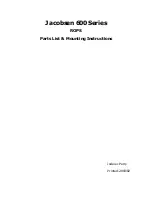
29
Subject to change without notice
Auto Set
Mean Value Display
Attention:
In combination of chopped DUAL mode and high ex-
pansion ratios in DELAY mode, chop interference may
be visible. This can be overcome by selecting alternate
DUAL mode by briefly pressing simultaneously CHI
and DUAL buttons.
AUTO SET
The instrument specific information regarding this function is
part of the section ”Controls and Readout” paragraph
AUTO
SET (2)
. As also mentioned in that section all controls are
electronically selected with the exception of the
POWER
and
calibrator frequency (CAL 1kHz/1MHz) pushbuttons as well
as the
FOCUS
and
TR
(trace rotation) control.
Thus automatic signal related instrument set up in Yt (time
base) mode is possible. In most cases no additional manual
instrument setting is required.
Briefly pressing the
AUTO SET
pushbutton causes the
instrument to switch over to the last Yt mode settings
regarding
CH I
,
CH II
and
DUAL
. If the instrument was
operated in Yt mode, the actual setting will not be affected
with the exception of
ADD
mode which will be switched off.
At the same time the attenuator(s) (
VOLTS/DIV
) are
automatically set for a signal display height of approx. 6 div
in mono channel mode or if in
DUAL
mode for approx. 4 div
height for each channel. This and the following explanation
regarding the automatic time coefficient setting assumes that
the pulse duty factor of the input signal is approx. 1:1.
The time deflection coefficient is also set automatically for a
display of approx. 2 signal periods. The time base setting
occurs randomly if complex signals consisting several
frequencies e.g. video signals are present. If cursor voltage
measurement is selected, AUTOSET also affects the position
of the CURSOR lines. Please note
AUTOSET (2)
in section
”Controls and Readout”.
AUTO SET
sets the instrument automatically to the following
operating conditions:
AC or DC input coupling unaltered
or in GD condition the previously used setting
Internal triggering (channel I or channel II)
Automatic peak (value) triggering
Trigger level in electrical midrange position
Y deflection coefficient(s) calibrated
Time base deflection coefficient calibrated
AC trigger coupling (except DC trigger coupling)
SEARCH and DELAY time base mode switched off
X x10 magnifier switched off
Automatic X and Y position settings
Trace and readout visible.
If
DC
trigger coupling had been selected,
AC
trigger coupling
will not be chosen and the automatic trigger is operative
without the peak value detection.
The
X position is set to the CRT center as well as the Y position
in
CH I
or
CH II
mode. In
DUAL
mode the channel I trace is
set to the upper half and the channel II trace to the lower half
of the CRT.
The 1mV/div and 2mV/div deflection coefficient will not be
selected by
AUTO SET
as the bandwidth is reduced on these
settings.
Attention!
If a signal is applied with a pulse duty factor of approx.
400:1 or larger, an automatic signal display can not be
performed. The pulse duty factor causes too low a Y
deflection coefficient (sensitivity too high) and too
high a time deflection coefficient (time base speed to
slow) and results in a display in which only the base-
line is visible.
In such cases it is recommended to select normal triggering
and to set the trigger point approx. 0.5div above or below the
trace. If under one of these conditions the trigger indicator
LED is lit, this indicates the presence of a signal. Then both the
time coefficient and Y deflection coefficient should be reduced.
Please note that a reduction in intensity may occur, which
could result in a blank screen when the physical limits are
reached.
Mean Value Display.
The DC Mean Value is displayed in place of the cursor line
measurement, if the cursor lines are switched off, MEAN
VALUE
ON
is activated in the menu MISCELLANEOUS
(submenu of SETUP) and further conditions are met:
The signal to be measured (AC > 20 Hz) must be applied at
input CH I (26) or CH II (30) with its DC content at the measuring
amplifier; DC input coupling (27) (31) required. Yt (time base)
mode in combination with internal triggering (trigger source
CH I or CH II; not alternated triggering) must be present. AC-
or DC- trigger coupling must be selected.
If the aforementioned conditions are not met, “DC:?” will be
displayed.
The mean value is acquired using the trigger signal amplifiers
for internal triggering. With the exception of DUAL mode, the
indicated mean value is automatically related to the active
channel (CH I or CH II), as the channel selection also selects
the assigned trigger amplifier. In DUAL mode one can select
between trigger amplifier CH I or CH II for triggering. The
indicated mean value refers to the channel from which the
trigger signal originates.
The DC mean value is displayed with an algebraic sign (e.g.
“DC: 501mV” resp. “DC: -501mV). Overranging is indicated
by “ < “ resp. “ > “ sign (e.g. “DC<1.80V” resp. “DC>1.80V”).
Being dependent on a necessary time constant for mean value
creation, the display update requires a few seconds after a
voltage change.
The reading accuracy is dependent on the instrument
specifications (vertical deflection tolerance max. 3% from 5mV/
div. to 20V/div.). Although the tolerances are significantly
smaller in reality, other deviations such as unavoidable offset
voltages must be taken into account, which may cause a
display deviating from 0 Volt without signal applied at the input.
The display shows the arithmetic (linear) men value. The DC
content is displayed if DC or AC superimposed DC voltages
are applied. In case of square wave voltages, the mean value
depends on the pulse duty factor.








































